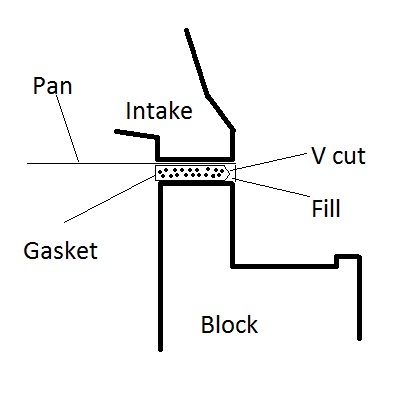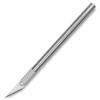By Mike Dailey
|
All of the technical information and product information posted on this website is offered as general information and is not recommended, endorsed, guaranteed or presented as professional technical information. It is recommended that you seek professional help for the repair or maintenance of your car. Improper self-maintenance or repair of your car can result in serious injury and or death. Use of this information is done at your own risk. |
October 10, 2012
The Cleveland intake manifold gasket system can be a challenge when it comes to keeping a long-term perfect seal. The gasket system is comprised of the metal pan that shields the bottom of the intake and seals around the intake ports, and rubber, like plastic end seal parts for the front and back of the intake. The plastic end seals are really bad and it is common for them to split and leak. See my intake gasket install experience here.
Rather than using the plastic end seals I've had better luck using custom made cork pieces. Some folks just use RTV without the end seals to seal the gap but there is some concern that RTV pieces will come lose and cause problems in the engine oiling system.
The cork gaskets I made held up really well but after ten years, the back one started weeping in a couple of areas. The normal solution would be to remove the intake, buy a new $45 gasket set and redo the gasket installation. But getting a good oil and vacuum seal on the intake is not always guaranteed with a new gasket set and the problem I had was related only to the back gasket in a couple of places. The worst weeping I had was in the center part of the gasket, so I decided to test a repair idea.

The cutaway drawing above shows the lower back edge of the intake manifold, the shield pan edge, the cork gasket and the back of the engine block.
The first step, is cleaning the gasket area really well to remove any oil residue. I used carb cleaner. If you are not sure of the oil weeping source, the area can be cleaned and the car driven for awhile to find the oil weeping starting point along the gasket. After the area is clean, use a X-acto knife with a #11 blade and cut the gasket at a 45 degree inward angle along the lower edge of the intake manifold. Remove the cut gasket parts. Then heat the tip of the X-acto blade and bent the last 3/16 " of the tip at an 45 degree angle. With the bent tip, cut from the block side up into the gasket at a 45 degree angle. Remove the cut gasket parts and scrape away any old sealer from the newly exposed edge of the block and intake manifold (actually the lower side of the splash pan edge). Clean the area again and let dry. I used carb cleaner. After dry, mask along the lower vertical area of the intake manifold and the block next to the area to be filled. I used blue masking tape.
I used Permatex Ultra Black RTV silicone PX #82180 that has maximum oil resistance to fill the cutaway area. Work the RTV into the cutaway area with tooth pick to make sure it is in good contact with the gasket, intake manifold and block, and filled the open area completely without air gaps. Then using a flat blade, smooth the RTV along the fill area so it is flush with the vertical line of the back edge of the intake manifold. This gets messy, but the masking tape protects the areas that you do not want covered with RTV. After the area is smooth and before the RTV starts to cure, remove the masking tape resulting in a clean sharp edges along the fill. Let the RTV cure for 24 hours before running engine.
View of the completed repair. I did the center section that is hidden behind the oil pressure sender as a test area for my repair idea about a year ago. After I was satisfied with the results I recently repaired from the center area all the way over to the right head. For best access, remove the oil pressure sender. So far the repair seems to work really well, looks clean, and saved the time and expense of pulling the intake manifold off.
